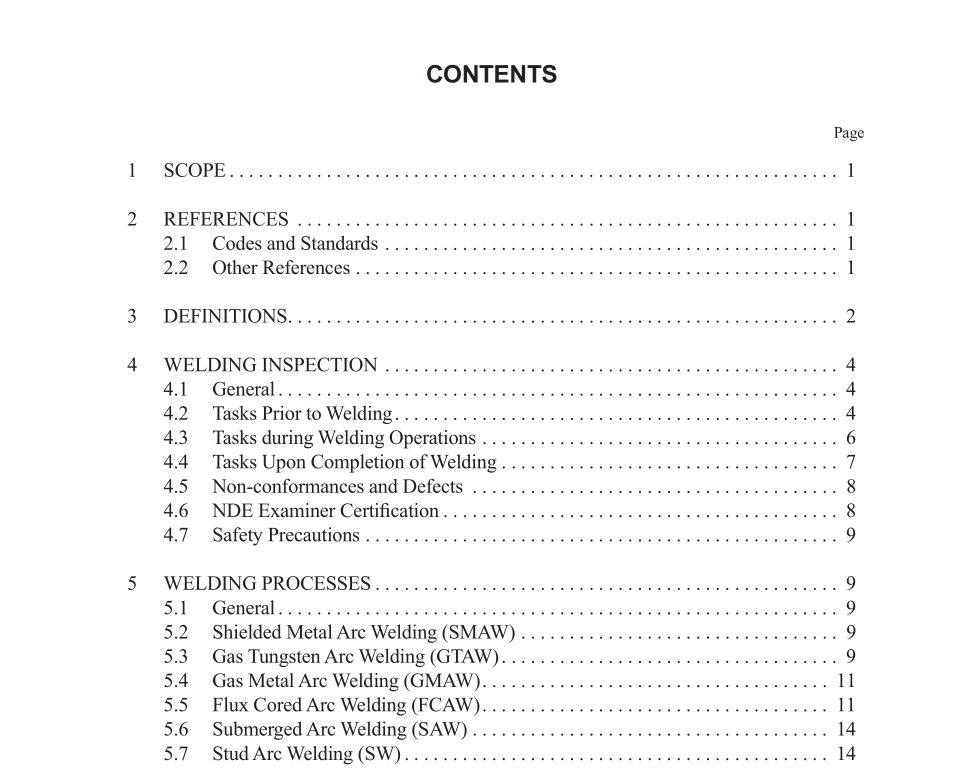API RP 577 pdf download

API RP 577 pdf download.Welding Inspection and Metallurgy
1 Scope
This recommended practice provides guidance to the API authorized inspector on welding inspection as encountered with fabrication and repair of refinery and chemical plant equipment and piping. Common welding processes, welding procedures, welder qualifications, metallurgical effects from welding, and inspection techniques are described to aid the inspector in fulfilling their role implementing API 510, API 570, API Std 653 and API RP 582. The level of learning and training obtained from this document is not a replacement for the training and experience required to be an American Weld- ing Society (AWS) Certified Welding Inspector (CWI). This recommended practice does not require all welds to be inspected; nor does it require welds to be inspected to spe- cific techniques and extent. Welds selected for inspection, and the appropriate inspection techniques, should be determined by the welding inspectors, engineers, or other responsible personnel using the applicable code or standard. The impor- tance, difficulty, and problems that could be encountered dur- ing welding should be considered by all involved. A welding engineer should be consulted on any critical, specialized or complex welding issues.
3 Definitions
The following definitions apply for the purposes of this publication: 3.1 actual throat: The shortest distance between the weld root and the face of a fillet weld. 3.2 air carbon arc cutting (CAC-A): A carbon arc cut- ting process variation that removes molten metal with a jet of air. 3.3 arc blow: The deflection of an arc from its normal path because of magnetic forces. 3.4 arc length: The distance from the tip of the welding electrode to the adjacent surface of the weld pool. 3.5 arc strike: A discontinuity resulting from an arc, con- sisting of any localized remelted metal, heat-affected metal, or change in the surface profile of any metal object.3.6 arc welding (AW): A group of welding processes that produces coalescence of work pieces by heating them with an arc. The processes are used with or without the application of pressure and with or without filler metal. 3.7 autogenous weld: A fusion weld made without filler metal. 3.8 back-gouging: The removal of weld metal and base metal from the weld root side of a welded joint to facilitate complete fusion and complete joint penetration upon subse- quent welding from that side. 3.9 backing: A material or device placed against the back- side of the joint, or at both sides of a weld in welding, to sup- port and retain molten weld metal. 3.10 base metal: The metal or alloy that is welded or cut. 3.11 bevel angle: The angle between the bevel of a joint member and a plane perpendicular to the surface of the member. 3.12 burn-through: A non-standard term for excessive visible root reinforcement in a joint welded from one side or a hole through the root bead. Also, a common term used to reflect the act of penetrating a thin component with the weld- ing arc while hot tap welding or in-service welding. 3.13 constant current power supply: An arc welding power source with a volt-ampere relationship yielding a small welding current change from a large arc voltage change. 3.14 constant voltage power supply: An arc welding power source with a volt-ampere relationship yielding a large welding current change from a small voltage change.3.15 crack: A fracture type discontinuity characterized by a sharp tip and high ratio of length and width to opening dis- placement. 3.16 defect: A discontinuity or discontinuities that by nature or accumulated effect (for example total crack length) render a part or product unable to meet minimum applicable acceptance standards or specifications. The term designates rejectability. 3.17 direct current electrode negative (DCEN): The arrangement of direct current arc welding leads in which the electrode is the negative pole and workpiece is the positive pole of the welding arc. Commonly known as straight polarity. 3.18 direct current electrode positive (DCEP): The arrangement of direct current arc welding leads in which the electrode is the positive pole and the workpiece is the nega- tive pole of the welding arc. Commonly known as reverse polarity.









